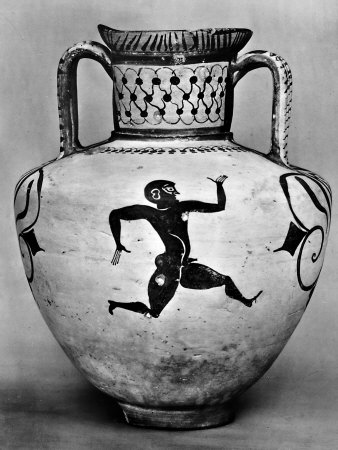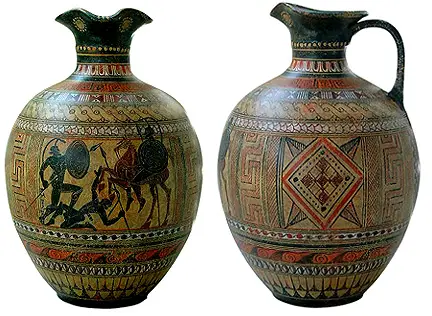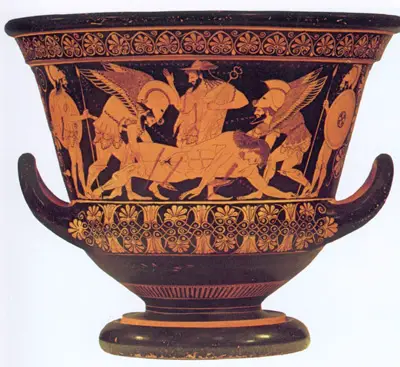Ancient Greek Vases: Pottery was one of the key features of Ancient Greek handicrafts. Handicrafts were in great demand in Ancient Greece and were made both as part of hobbies and also provided vital employment to the people. Clay was the chief component in the making of pottery. The Ancient Greeks used large deposits of clay to make pottery. All the Ancient Greek city-states were pioneers and major players in the making of pottery, but special mention must be about the largest city-state, which was Athens. By the year 1000 BCE, Athens had become one of the leading cities in making pottery. The Ancient Greeks made two basic kinds of pottery. One was red-figured and the other was black-figured. Other minor variants also perhaps existed.
Among the pottery of the Archaic Greeks, vase-making was the most prominent. The making of vases was also not very difficult. They simply used red and black clay to form red and black figured Ancient Greek-style vases. The songs of many ancient poets are lost, while the illustrations of their songs remain on pottery vases.

Making of the Ancient Greek Vases
The most frequent form of the vase was the amphora which was also an Ancient Egyptian and Phenician form. It was of a long cylindrical or ovoid body, made in all sizes. It was made from a small drug vase, two or three inches high to the large receiver of oil, grain, fruit, wine, or water.

Originally the base was pointed, to be pressed into the sand or soil, and thus held the vase upright. But in later periods, and always in ornamental vases, the pointed base was surrounded by a small foot.
The invariable two handles gave the name to the vase. This was a favorite vase for decoration, and, thus finished, was a noble household ornament and adornment on festival occasions. It was thus the highest and most dignified form of a vase made by the Ancient Greeks.

Painting on the Ancient Greek Vases
Although the Ancient Greek people had a tendency for art and painting, their painting has survived primarily in the form of vase painting. Vase painters were those painters who only focussed on beautifully painting and decorating the vases. They articulated individual forms by incising the slip or by adding white and purple enhancements (mixtures of pigment and clay). The paintings were done in red and black with some use of accent colors.
The vases depicted battles, Ancient Greek heroes, gods and goddesses, and different events of day-to-day life. During the first phase of the oxidizing stage, the air was allowed into the kiln, turning the whole vase into the color of the clay. In the subsequent stages, green wood was introduced into the chamber and the oxygen supply was reduced which caused the object to turn black in the midst of the smoky environment. This was how the painting work was performed.

Shapes developed in the Vase Pottery
In the third stage of creating the vase, the air was reintroduced into the kiln and the reserved portions turned back to orange while the glossed areas remained black. Painted vases were often made in specific shapes for specific daily uses. They included storing and transporting Greek wine and foodstuffs, drawing water, drinking wine or water, and so on. In the case of special functions such as ritual occasions, there were other measures. These included pouring libations or carrying water for the bridal bath, to name a few of them.
Kinds of Ancient Greek Vases
The shapes and sizes of the Ancient Greek vases were determined by the function and use they performed. “Lekythos” were vases used for oils, “aryballos” were the ones used for cosmetics and “alabastron” were used to keep perfumes. Both the “aryballos” and “alabastron” were much smaller in size than the “lekythos.” “Krater” and “dinos” were large, wide, and spherical mixing vessels. There were several kinds of cups and jugs, which may be listed as follows-
1. Kylix
2. Kantharos
3. Phiale
4. Oinochoe
5. Skyphos
6. Iotrophorus.
Vase Making in Athens
Black and Red ware techniques were used in Athens during the 6th to 4th centuries BCE. Athenian pottery was either kept simple or highly decorated. Vases were made in various ways- neck and body separate and an attached foot, which was connected later. They were joined by clay which was the basic material used for making these designer vases. It also had decorative handles. The black and red motifs were different in nature. Redware was perhaps discovered by the potter Andokides in 530 BCE. Gradually the blackware technique was replaced by the redware technique. A brush was used in the redware system to better denote the naturalistic representation of garments, emotion, and anatomy.
There were three stages in the firing processes of both the black and redware potteries. Air moved to the kiln in the oxidizing stage which turned the whole vase into the color of clay. Greenwood was introduced in the subsequent stage into the chamber and oxygen was reduced which caused the object to turn black in the smoky environment. In the third and final stage, the air was reintroduced into the kiln, the reserved portions turned back to orange while the glossed areas remained black.
As mentioned earlier, painted vases were used in specific daily chores or in special rituals. They also came in various attractive and different shapes. The pictorial depictions on these vases provided many insights into the Athenian way of life and complemented the literary texts and inscriptions which were found from the Archaic and Classical periods of Ancient Greek history.